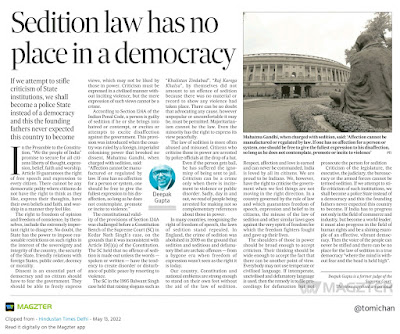The other side of sedition
Media Watch
The sedition law got much
media attention in the past week, thanks to the Supreme Court’s freezing of the
colonial law. Not one newspaper or magazine that I read supports the sedition
law. Every one of them welcomes and appreciates the SC’s interim order.
Writing in
the Hindustan Times of 13 May, former judge of the SC, Deepak
Gupta, asserts in no uncertain terms that the “sedition law has no place in a
democracy.” Who wants to retain such an antiquated law? Those who are afraid of
criticism do. Stifling criticism is to create a police state, argues Gupta.
Certain restrictions are required when it comes to freedom of expression. No
nation can afford to compromise its security, foreign relationships, public
order, decency and morality. But putting charges of sedition on people who
criticise the government’s policies is to invite troubles.
Gupta quotes
Mahatma Gandhi who was arrested for sedition by the British. “Affection (for
the government or country) cannot be manufactured or regulated by law,” said
Gandhi. “If one has no affection for a person or system, one should be free to
give the fullest expression to his disaffection, so long as he does not
contemplate, promote or incite to violence.” The disaffection that
Gandhi was referring to was the one mentioned in Section 124A of the Indian
Penal Code which criminalises “exciting disaffection against the
government”. Gupta implicitly suggests that no government with self-confidence
requires the sedition law.
The Times
of India’s editorial on 12 May bluntly asks the government to scrap the
sedition law. “Don’t just reform – remove,” screamed the title of the editorial.
Even a mild version of the law will be misused, the editor thinks. This law in
any shape will provide the opportunity for politicians to settle scores with
rivals or critics. The newspaper goes on to say that even UAPA needs be
scrapped.
The Free
Press Journal’s editorial of 13 May mentions that about 13,000 people
are in prisons now charged with sedition. The number alone hints at the blatant
misuse of the law. Many of these prisoner won’t be convicted since their crimes
won’t amount to anything like sedition. But the mere detention is punishment.
The Morning
Standard also mentions the number 13,000 and adds that 60% of them were
implicated after the BJP came to power at the centre. The newspaper’s editorial
(12 May) states explicitly that the ruling party is abusing the law.
D Raja of the
CPI wrote an article in the Indian Express of 13 May arguing
vociferously against the sedition law and added that cases under the UAPA have
increased by about 75% between 2017 and 2020. The BJP is obviously too scared
of criticism. The party does need a stronger backbone.
*
The Open
magazine has Siddharth Singh writing a long article about the freebies being
given to people by governments for the sake of (cheap) popularity. Interestingly,
the writer cites examples only from Punjab and Rajasthan, two non-BJP states.
One wonders why he fails to see more freebies being given by the Modi
government as well as the BJP state governments.
His question
is valid, however. Should governments indulge in such populist measures which
are rather costly by any criterion? Shouldn’t governments focus on policies and
acts that bring in welfare for all instead of select groups? Shouldn’t governments
have clearer vision about brighter future for all people instead of giving alms
to the people?
*
The Week this time has dedicated half of its pages to the preeminent Bengali film maker, Satyajit Ray. His classical movie Pather Panchali has survived 7 decades. The Week argues that the contemporary Bengali cinema is too substandard in comparison with Ray’s movies. There is a parallel decline in Bengali literature too. It is quite amazing that a people that had artists and writers who scaled enviable peaks of excellence are now fumbling in the dark alleys of mediocrity. What has happened to Bengal? The Week wonders.
*
That question about Bengal can
be extended to the whole of India now, I think. That is quite tragic. Why are
we obsessed with the past? Why are we interested in the dark chambers of the
Taj Mahal instead of the bright possibilities that should be explored for the
sake of the emerging young population of the country? Why are we stuck in the
quagmire of history instead of dealing with the present and its innumerable problems?
PS. Last Media Watch: Exotic India


Hari OM
ReplyDeleteTop notch round up again, my friend! Interesting that there is starting to be a revolt against the sedition law - do the voices for this run risk themselves? Here in the UK, the government is seeking to finalise a bill that will give the police greater powers to detain anyone protesting, such as environmental activists, women's rights, race rights, workers rights... in other words, criticism of the ruling party by raising a banner is likely to land one in gaol. Backward indeed... YAM xx
It's a good sign that the Indian media gathered the courage to speak this much. Let's hope things will change for the better.
DeleteOur 'leaders' wish to dwell in the past as they have no vision for the future and they wish to keep the populace numb in the past.
ReplyDeleteExactly. Lack of vision keeps us rooted in the past.
Delete